| |||
| Capital City | Feruche | ||
| Official Language | Ossetic | ||
| Other Languages | English French | ||
| Head Of State | Ambrai XIII | ||
| Motto | Gev'im Iseni - Of The People | ||
| Heir Apparent | Crown Princess Kateryn-Elise | ||
| Legislature | Magisterial Council (13 members elected by popular vote, led by the Prince) | ||
| Currency |  The Ossetian R£20 Note | ||
| Area • Total |
1,352.273 mile diameter. 550.031 in purchases, 114.132 in modifiers, 688.110 in growth(05/22/10) | ||
| Population • Civilians • Military |
66,514 Supporters (05/22/10) 44,014 Working Citizens (05/22/10) 22,500 Soldiers (05/22/10) | ||
| National Tax Rate | 30% | ||
| Average Income | $336.99 (after taxes) | ||
| Literacy Rate | 100% | ||
| Currency | 1 Rupee ($) = 100 Coins | ||
The Princedom of Ossetia is a medium sized, mostly developed, and ancient nation at 1376 days old with citizens primarily of Celtic ethnicity who follow mixed religions. Its technology is first rate and its citizens marvel at the astonishing advancements within their nation. Its citizens pay extremely high taxes and many despise their government as a result. The citizens of Ossetia work diligently to produce Wheat and Aluminum as tradable resources for their nation. It is a mostly neutral country when it comes to foreign affairs. It will usually only attack another nation if attacked first. Ossetia is currently researching nuclear technology for the use of nuclear power plants but believes nuclear weapons should be banned. The military of Ossetia has been positioned at all border crossings and is arresting all drug traffickers. Ossetia allows its citizens to protest their government but uses a strong police force to monitor things and arrest lawbreakers. It has an open border policy, but in order for immigrants to remain in the country they will have to become citizens first. Ossetia believes in the freedom of speech and feels that it is every citizen's right to speak freely about their government. The government gives foreign aid when it can, but looks to take care of its own people first. Ossetia will not make deals with another country that has a history of inhuman treatment of its citizens.
The above information is correct as of - 05/22/10
The history of the country can be traced back to it's origins as a province of the former Kingdom of Hyrule. The kingdom had been subject to internal civil war for the past several hundred years, with the kings unable to unite the fractious country. The provinces were called "dorvali" in the ancient Hylian tongue, translated as principalities, or princedoms. Each province was ruled by a prince who owed his position and power to the king.
Ossetia was one of the largest of these princedoms. By the time King Nohansen VI began his rule, royal influence had been limited to the several hundred miles outside the capital city. The then prince of Ossetia broke away from the power of the king and declared that Ossetia was now a country of it's own. The early years were volatile, with the office of the prince eventually becoming limited to an elected one. Assassinations were common with the unstable politics of the time, but the state managed to hold together. By the time Nohansen IX of Hyrule had united the country and finally solidified a lasting peace, Ossetia had stood long enough to become a well-developed country by itself, seperate to Hyrule.
As Prince Velden's reign was ending due to his failing health, there were no suitable men among the representatives of those who would run for office - as far as Velden was concerned, they were all corrupt. Although Nohansen IX had been usurped by the tyrant Dragmire, he had unified the country in peace and the benefits of an absolute monarchy were plain to see. Velden sent for a Hylian lord, Link Ambrai, and spoke with him. Ambrai was popular among the people throughout the two countries, seen as a ruler that was fair but posessed of a firm hand, and his resentment of Dragmire's crushing reign was well known. Days before Velden's death, with the support of the Magisterial Council, he announced that the monarchy would become an absolute one. There was uproar among some, but most seemed to agree that the stability brought about by a single ruler with absolute power would be worth the move. The day he died, the proclamation of his final orders were announced - usually these would be a strong vote for a successor among the representatives of the people. Instead, he emphasised the country's history as a province of Hyrule, and pronounced Lord Link Ambrai of Hyrule, the new Prince Ambrai I of Ossetia.

Reiza Palace, the summer residence of the royal family.
When he learned of this, Dragmire, who had been planning an invasion of Ossetia, confiscated all of Ambrai's Hylian lands, and marched immediately on the country. Over the course of several years and several battles, Ossetia defeated Hyrule and took much of it's land. Ambrai I stabilised the country, and by the time of his death was a beloved ruler. Thus the Ambrai line was established, and the Princedom of Ossetia as it is known today was born.
Ossetia has it's own unique culture and language - foreign languages are not pursued except as a means of communication with other countries. Both English and French have become popular however, and Ossetic is seeing a decline; the Magisterial Council actively promotes the use of the language over all others. For the majority of it's existence, Ossetia has been a relatively isolationist country, retaining loose links with it's tribal past with the dying tribes of the desert. It traded and allied with the nearby Hylian Kingdom, but otherwise remained on it's own, a small yet nevertheless powerful country that looked to it's own affairs before bothering with others. In recent years the Ossetian borders have been opened up and immigration is rife. All immigrants are, however, required to attain citizenship and learn the native language before being allowed into the country. Anyone found in the country without a citizenship is immediately deported to their country of origin.
The country's currency is regulated by a small committee of the Ossetian Central Bank, which answers directly to the Magisterial Council. This has proven to be a sound system in that no bank or financial force can run the government into debt by controlling the currency themselves, unlike other countries. There are no contractors that can profit from an Ossetian war - all military technology, save for a few small weapons and the bomber aircraft that is bought externally, is developed by the government itself. War, therefore, has a devastating affect on the economy, and it is impossible for anyone to profit financially. All of the banks are controlled in a manner of speaking by the Magisterial Council through the Central Bank, which cannot act of it's own accord to profit by manipulating any competing bank or other financial institution. The Central Bank is closely monitored and controlled to ensure this, as stated in the 684th Royal Decree, drafted and signed by Prince Deniv Ambrai X.

National University of Ossetia
Education is of a particularly high standard, with emphasis on history, languages, mathematics and the arts. There are many colleges of different types in the country, but the most prestigious are the two universities, Schola Ossetia Academia, and the National University of Ossetia, which offer the widest variety of courses and subsequent career options.
Many of the people protest often about either the policies of the monarchy, especially those regarding nuclear weapons, or just that the monarchy itself is still in power in these modern times of constitutional republics and democratic countries. Most see the monarchy as an outmoded institution, and are vocal in their opinion that a proper, full government is needed. Prince Riyan Ambrai XI accepted this in the early years of his reign, and created the Magisterial Council in place of a full republican government. This way, both the monarchy and a democratic organisation run the country. However, the power of the monarchy is still absolute, such as the power to remove the Magisterial Council if the prince decides it is needed. Most Ossetians wish to have this power removed, or at least curbed to a high degree. Protests are held every weekend outside the Athlante and Reiza palaces, and thousands usually turn up. The protests fall under free speech in Ossetian law and thus are allowed. So far there have not been any violent methods employed as a strong police force monitors things closely, and the royal residences are well protected.
Military[]
Ossetia has a glorious military past, successfully defending itself during the medieval period with an advanced, well-trained army. When isolationist tendencies were adopted, the military quickly became redundant, but it remained nevertheless, and still retains it's proud traditions today. The order of the military that protects the prince is still called the Royal Knights. There were two wars in the early years of Prince Ambrai XI's reign, the first against Bfod Nation. Wishing to claim more land for itself, Ossetia invaded with a force of eight hundred troops and five tanks, having first launched two cruise missiles. Ossetia lost the first battle with a loss of 258 soldiers, against Bfod Nation's 79 infantry, but was victorious in the second battle with an increased infantry presence. An additional four hundred infantry was added to the army - Bfod Nation lost all troops. Ossetia went on to destroy some of Bfod Nation's infrastructure before going onto claim territory and technology for itself before sending peace terms, which Bfod Nation accepted. A monument was erected in Feruche, dedicated to the memory of the 258 Ossetian troops that lost their lives in the Bfod conflict.
Before the war with Bfod Nation, Ossetia sent 536 troops to Kanosia to help in their war. These troops stormed Kanosia's enemies' defenses, and brought a successful close to the conflict. 186 of these troops were recalled after the war, but 333 remained in Kanosia as a peace-keeping force. These however, were never to return home as Kanosia mistakenly attacked another nation. At first peace was offered by the other nation provided Kanosia pay for the small amount of damages incurred, but Kanosia refused. War broke out again and the other nation called to it's alliance for help, and two other countries also attacked Kanosia. The country was devastated - militarily, economically, financially. The land was razed. Kanosia called for help and Ossetia sent over 800 troops and 70 tanks to help defend it while at the same time warning the attacking countries to call a peace. Eventually higher members of the alliance opened a dialogue with both Kanosia and Ossetia, and the war came to a close, but for one nation, which kept the theatre of operations going, yet according to the command issued by his alliance, did not attack. Kanosia's war had come to an end, but for Ossetia, it was just beginning.
A conflict broke out between Ossetia and a nation called Andromeda. Ossetia launched a midnight attack with cruise missiles and a strong force of infantry and tanks. Andromeda called to it's alliance for help and, mirroring the last war with Kanosia, helped to defend the other nation, and then attack Ossetia itself. Prince Ambrai XI offered peace, but was refused.
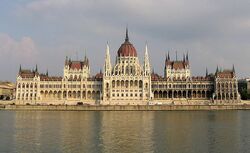
Radzyn Palace, home of the Magisterial Council
The country was overwhelmed, and emergency draft measures were called for. However, these new troops were inexperienced and the entire military fell apart. Vast Ossetian estates were taken while much of it's technology was stolen, shared equally among the three countries attacking. Again the military, hastily reformed by General Ti'ahk, used the emergency draft system in an attempt to repel the invaders, helped eagerly by thousands of Ossetians angry at what they saw as the desecration of their nation. They used guerilla tactics but were again beaten back and forced to surrender. Feruche fell to the invaders, while what was left of the government and military rallied at Reiza. While Ti'ahk requested financial aid from Kanosia, Prince Ambrai XI negotiated the entry of Ossetia into the Vernatic Zeal Consortium, a small protectorate of Nordreich. In effect, Ossetia was now a Nordreich nation. While they readied for war, peace was finally accepted, provided Ossetia apologised for attacking at first, a provision it gladly accepted.
The war had utterly devastated the country - it is estimated that over two thousand people lost their lives, including both the military and civilians who resisted at Feruche for so long. The economy was extremely weak and aid was called for. Kanosia, finally recovering itself from it's own war, sent $60,000. The VZC sent $150,000. And yet despite the immense setbacks the war had brought, recovery was amazingly quick. With the construction bonus afforded by the country's trade agreements, much of what had been destroyed was rebuilt. The land taken was given back, and much more outside of this was claimed for Ossetia, which asserted it needed the land for farming to rebuild the economy. Immigrants flocked to the country for the work available, and then for the high pay rates when the economy recovered. Indeed, in a very short time, the entire country strongly exceeded it's pre-war status.
War struck again, this time on a global scale with the advent of the Second Great War between the League and the Initiative. As a member of Nordreich, Ossetia stayed out of the war but expressed support for the Initiative. On January 14, secret orders were passed down among the military divisions in Nordreich, known as the Korps. Each Korps was to focus on a select number of nations from Nordreich's enemy alliance, ODS and LSF. Ossetia was one of the many nations which attacked that night, focussing on ODS member the Roam Empire.
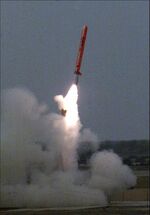
An Ossetian XR-5 cruise missile
Within days, Roam was in anarchy, and accepted surrender at Ossetia's terms (that being, to leave the ODS). In a matter of days, the League was under heavy fire and called a ceasefire, eventually surrendering. Refusing to surrender, the LUEnited Nations continued with the war. Ossetia again came to Nordreich's aid and attacked Zagaland, the result of which was the complete destruction of the state - after a total victory, Ossetia claimed much of it's territory and parceled out what regions it did not want to neighbouring countries. The League surrendered to the Initiative, and though there were a few rogues still being hunted down, it was mostly over.
However, it would be a while before Ossetian citizens saw peace, as Splabonia (being another member of Nordreich) attacked ICP nation Vindrille. Kanosia also attacked, and finally, Ossetia declared war. What followed was mostly a war of attrition - after the initial battle, which Vindrille lost badly, the country was put into anarchy. Riots filled the streets while Kanosian and Splabonian tanks and troops hunted down the government in hiding. In the air, Ossetian aircraft followed cruise missiles in attacks on the beleaguered nation. What was left of Vindrille's government rallied at a military base and launched cruise missiles at all three nations. The Magisterial Council opened a dialogue with the surviving parliamentary members, who refused to surrender. All three nations reduced the country to ashes and divided the territory equally among themselves.
Ossetia fought in the Third Great War as a member of Nordreich, fighting a crucial war on three fronts (fighting nations from three different enemy alliances). The country acquitted itself well and either destroyed or forced all of it's enemies to submission. Though not a member of any fireteam, Ossetia was one of the more active nations of the Mjolnir Korps, and she was recognised for her contribution to Nordreich's efforts in the war. The war had taken a large toll on the country, despite it's successes, and several aid packages were awarded by the Reichsbank for it's service when the war had ended. More Ossetians died in this war than any other, but this did not stem the immense growth the country enjoyed at the time.
Regarding the Karma War, Prince Ambrai XII at first advocated to stay out of the conflict. However, as the war dragged on he ordered a review of the country's military, presiding over a rare meeting of the Magisterial Council and the heads of staff of the Ossetian Army, Royal Navy and the Royal Airforce. After a comprehensive review, it was decided that Ossetia was hopelessly unprepared for such a large conflict and if she were to enter and be of any consequence, radical policy changes would have to be immediately enacted. After a long consultation with Londo Mollari, head of Athens of which Ossetia is a member, it was agreed that Ossetia would indeed enter the war. The country was officially put into a state of emergency and preparations begun for battle on two different fronts, engaging member nations of the GGA and NPO respectively. Many young men and women, which had been crossing the borders into Ossetia's allies to fight in the war, were now signing up for the Ossetian Armed Forces, and Prince Ambrai XII made an impassioned speech about the evil necessity of this war in particular and the hopes of the millions of people across the Karma alliances resting on those young shoulders - including those of his son, Prince Geir.
Air Force[]
Ossetia has always remained at the forefront of technological development. It has a space-flight development programme currently in the planning, an offshoot of the government's MRG (Military Research Group) group. MRG supplies military and civilian flight technology. During the war with Bfod Nation, the military did not believe in the advantage offered by aircraft, because the craft of the time were primitive propellor-driven machines.
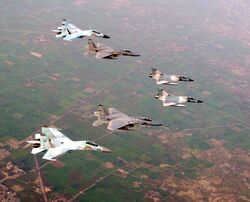
Three generations of Ossetian fighter craft - two OA-5's fly in V formation with two OA-4's (middle) and two IFV-4B's, just prior to the outbreak of the Third Great War
MRG had developed and built the OA-1 and several units were active at the time, but they were not used. The organisation split it's research teams in two - the first would retain the MGR name and develop military aircraft under the original managing director, focussing on weapons. The second, named 2GR (2nd Generation Research), would also develop it's own military aircraft, but focus on engines. By the time of the war with Andromeda, all the military had was a few OA-1's and 2GR's R6A-E. These craft were outclassed by the planes operated by the enemy, and all that had been sent out were destroyed. When the war was over and the military re-structured, orders came from the government to give a greater focus on aircraft, and a generous amount of funds was diverted into the research of new machines.
MRG at first concentrated on a follow-up to the OA-1, the OA-2, focussing on the improved new automated guns they had developed. They scrapped the OA-2, however, after 2GR's latest aircraft was secretly revealed to the prince and the Magisterial Council, the GL8-A. While it was still weak in the weapons department, it utilised a new technology for it's engine, the jet. This greatly improved the speed and maneuverability of the fighter, the prototype of which outflew and outmaneuvered the OA-1, R6A-E and the OA-2 prototype. While the government rushed the GL8-A into production, they ordered 2GR to work on a follow-up while the jet engine was to be given to MRG to combine with OA-2 technology. The result was the OA-3. Externally, it looked very similar to the GL8-A, but it had greatly improved weapons and a slightly higher speed due to a refined engine.
Eventually, Ossetian air technology was at the top of it's class. At the outbreak of the Second Great War, Ossetia had two squadrons of GL8-A fighter craft, one OA-3 squad, four GL8-C squadrons, two IFV-4 squadrons, and one squadron that flew the new OA-4. During the war, among the various dogfights and fighter escorted bombing runs on enemy countries, the two GL8 squadrons were destroyed. As they were older craft, this is not surprising. Another result of the war was that the country did not have enough funds to create any more OA-4 squadrons at the time - it was estimated that it would take quite some while before any more could be manufactured, and all development at MRG and 2GR shut down for an extended period.
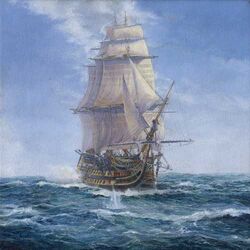
ONV Triumphant
Shortly before the Third Great War, development and production started up again, and MRG produced the devastating jet fighter, the OA-5. Twenty squadrons were in active service during the war, along with ten squadrons of the B-1B Lancer bomber, the largest number of active aircraft squadrons in the country's history. Shortly after the Third Great War ended with a victory for Ossetia and her allies, 2GR announced their latest craft, the FXX-A4 "Phoenix". This extremely expensive aircraft has replaced the OA-5 as the only fighter in active service in Ossetia today. It is roughly comparable to the popular F-22 Raptor as a multirole fighter.
When it came to bomber craft, Ossetia originally developed two, the OH-1 and the OH-2A, both developed by MRG. Squadrons of both were used in the war with Andromeda but neither craft actually managed to incur any damage, and the military scrapped them altogether, focussing at first on the fighters, which were overwhelmed by enemy craft. Today Ossetia buys bomber craft externally from either companies or other countries. Concerning the space-flight programme, there is nothing planned for human flight, but the country was expected to be launching satellites prior to the Second Great War using rocket technology developed at MRG. Initially developed for cruise missiles, the engines were adapted to suit spaceflight, carrying significant weight into orbit. However, due to the strain on the country's finances in the Great Wars, the program was put on hold. It was resumed sometime after the Third Great War, with successful launches of two military satellites. The program was recently extended for the joint Emiri-Ossetian moonbase on Titan, and includes a materials research laboratory alongside a large robotics division. Though Ossetia's involvement in the project is minimal next to Emiri's, due to their mutual goodwill it was agreed that both would take joint control. Ossetia's involvement is mainly limited to research projects, though several citizens have signed up to the program and are training in Amiri's extensive facilities.
[]
The Ossetian Royal Navy has it's origins in the early days of Prince Rohan Ambrai II's reign. Surviving records from the time show that an order came from the prince to construct three "jynate", or corvettes, to patrol the waters around the harbour and protect shipping from piracy. This fleet was later added onto and extended to protect the shipping lanes in between Ossetia and her nearby neighbours, though the ships remained much the same size. During the reign of Atreyu Ambrai VI, a proper port was built and the navy given an official royal designation. Some of the first of the large-scale sailing ships appeared around this time, with the Gerudo class becoming the mainstay ship type and becoming the first Ossetian vessels to actively participate in battles. During the reign of Prince Elsen Ambrai IX, what many call the golden age of the Royal Navy began. It started when it was proposed to replace most of the fleet with new ship types, an idea put forward was to construct a very large scale sailing ship to emphasise the power of the Royal Navy. An entirely new quay had to be built to accomodate these new ships, the size of which had never been seen before. The first ship began construction and was called the ONV Victorious, and after sea-trials were successful two more ships of the same class were proposed.
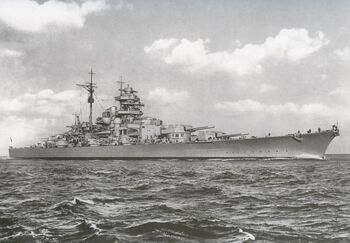
ONV Glorious, flagship and last battleship of the Royal Navy
As work began on the second ship, the Victorious acted as both a protector of the shipping lanes and an ambassador to other countries, who, awed with her size and power, quickly began to construct their own vessels of a similar size. Construction was delayed on the second ship when the navy was commissioned to design and build what would become the MVK Graypearl, the flagship of the Kanosian navy. The Graypearl was completed in under two years and work on the second ship re-commenced. The Victorious and the Graypearl often worked alongside one another, however the Victorious was caught on her own one night during a particularly vicious storm and was sunk. An inquiry into the sinking revealed that the sails had been too large and therefore too heavy to reel in properly, so that the crew could not react in time when the storm became apparent. The masts were also too stiff and unyielding, which hastened her demise. Construction on the second ship ground to a halt while alterations were made to the design. Eventually a new rotating mast system was devised, while the size of the sails were reduced slightly, though many more were added to replace them. The size of the anchors was also increased.
Construction eventually resumed and the ship was given a name, ONV Triumphant. The Victorious had been designed to accomodate the prince in stately quarters, and the Triumphant was no different. Prince Elsen often sailed in her, as did Prince Deniv and, before he succeeded his father, Prince Riyan. She became the flagship of the Royal Navy and immediately resumed the duties of the Victorious. Groundwork was laid on the keel of a third ship of the class, but was delayed when the Kanosian navy again commissioned more ships, and eventually the third ship was scrapped altogether. Because she now had to take on the duties of what was to be originally three ships, the Triumphant was assigned three smaller vessels, belonging to the Farore class. They were intended to deal with pirate ships, so that by the time the hulking Triumphant came near, the Farore vessels had already dealt with the problem. The Triumphant remained as the flagship of the Royal Navy for close to eighty years, even though forty years into her time iron-clad warships were beginning to appear. She was of course not used for combat situations during these later times, although she had a long and distinguished combat record. She was eventually replaced by the ONV Glorious, a large battleship that would see a similarly long service record, and delaying of a replacement, even though she did not see combat in her later years, much the same as the Triumphant.
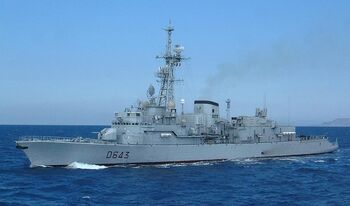
ONV Nayru on patrol
The previous monarch, Prince Amir Ambrai XII, entered into service on board the Glorious in her final year, when he was eighteen. Unlike the Triumphant, which is still preserved today, the Glorious was taken back to the quay where she was built to be scrapped. The current flagship is the ONV Nayru, a frigate. The current needs of the navy call for a large-scale vessel, and after considerable debate, the Navy has put in an order for the Emirian Vestutae class, one of the largest air-carriers in the world. A replacement design for the Nayru class has been proposed (the CX-1001) but they are likely not to be replaced for at least a decade.
Ossetia is developing nuclear technology but this program is very much in the early stages of development. The Magisterial Council voted for this weapon to be built and employed as a military weapon after facing nations during the Third Great War that carried their own nuclear weapons. Due to sanctions by their alliances, they were forbidden to and did not use them, but the Magisterial Council believed that Ossetian nuclear technology would be essential in future combat situations. There is a lot of stiff resistance to this among the people, but Prince Ambrai XI has overruled them, agreeing with the council. This is one issue of major contention between the prince and the general population, and one of the deciding factors in the campaign to remove the monarchy and form a liberal government. Since succeeding his father, Prince Amir Ambrai XII has insisted that the program should go ahead, but has cut funding by a severe amount, re-routing funds to social programs.
Miscellaneous[]

Original flag of Ossetia.

The current Ossetian flag, "The Golden Phoenix".
Some time after the third world war, Ossetia's ancient flag, seen here, was discarded. The new flag seen on the right has the ancient Phoenix in the centre, a sword in it's right talon to symbolise the military, and a parchment in it's left talon to symbolise the law. The wreath symbolises the government, while the crown on the head symbolises the Ossetian monarchy. In the original flag, the Phoenix was seen flying towards the sun. In the new flag, the Phoenix' wings are outstretched instead of folded in, and the sun shines brightly from behind it, which is supposed to highlight the immense advances the country has taken in recent years. The Dragon, an ancient symbol of House Ambrai, actually derives from the marriage of Prince Link Ambrai I to the Hylian noble Lady Aladra. The symbol of House Ambrai was a lion, and the symbol of Aladra's family, House Lonarai, a unicorn. During the coronation as the first prince of the new state of Ossetia, a new family crest was revealed - the unicorn on the left, the lion on the right, and inside the shield a gold dragon on a red field. The dragon remained as the official crest of the new royal family.
The Magisterial Council is a delegation of thirteen members who meet three times a week to discuss the running of the state. While each magistrate has a certain area of the country to specialise in, all thirteen members vote on every issue that is raised. Each term lasts five years, and a person can be voted to stay on as a member for a maximum of three terms. They are usually attended in their meetings by the prince, who, to ensure equality during voting, has two votes by default. While the prince is not always present, it was only until very recently that the body could make anything official without the approval and signature of the prince. When Prince Amir Ambrai XII began his reign, he passed a law that meant that the council could vote on and enforce any law they see fit without any need for his approval. While this is seen as a step forward, many people do not like that the monarchy still has such power, as Amir continues his father's policy of attending and voting at most sessions. The power of the prince is so absolute that he can dissolve the council and rule alone if he sees the need to.
Monarchy[]
The ruling family on the Ossetian throne is the House of Ambrai, descended from Ambrai I. The prince and his family are protected by the Jihan'Rei, an elite military unit. The motto to be found on the family's heraldry - Sapientia, Virtus, Vox - means Wisdom, Courage, Power. Prince Ambrai III became High Prince for a few short years, governing also the neighbouring kingdom of Hyrule (now the Democratic Republic of Kanosia), until a new government was installed. In recent years the general population has expressed their desire to move away from a monarchy, preferring a democratic government. However, Prince Ambrai XI gave no quarter in this area, going as far as to say - "I will not endeavour to remove that which has been in place for so long; I will not approve any form of liberal government in place of this monarchy. This family will continue to rule, advised as it is at present by the Magisterial Council. I will not break with tradition, and neither will my successor. We shall continue to serve the people in our current, traditional role." Indeed, after Prince Riyan died at the age of 89, and his son Amir became ruling prince at 53, this policy has since been re-asserted. The protests dimmed somewhat after Amir succeeded his father, with the royal family enjoying a level of popularity it hasn't seen since the days of Ambrai IX.
The family is on close terms with only one other royal family in the world - the Emirian Royal Family. Indeed, the former monarch was named after the country so fondly thought of in Ossetia, and Amir never failed to emphasise the honour he felt at his naming whenever the issue came up. The good relationship they share filters down to the common people in both nations, and is one of the largest reasons for the continued goodwill and sharing of technology that goes on today.
The royal family is structured as follows:
Kir'Rei, Azh'Rei - The prince and ruling monarch of the country, and the head of the family. In the native Ossetian tongue, "Kir'Rei" means High Prince, but it does not mean that the prince assumes this title; rather, it is merely to emphasise the role of the monarch. If a monarch did become a High Prince in the true sense of the word, as Prince Ambrai III did, then the title in the native language would be "Kir'Rei Tir".
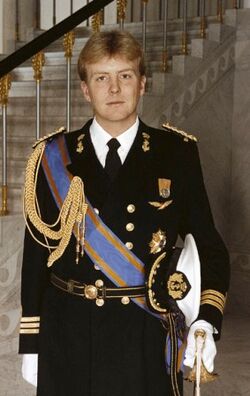
Prince Revia Ambrai XIII
Azh'Rei is a secondary title of affection that has been obsolete for centuries. First given to Prince Link Ambrai I and then to his successors Rohan Ambrai II and Pol Ambrai III, it has not been used since.
Kir'Reia - The ruling princess as wife of the prince, in terms of power she comes third behind the prince and then the Magisterial Council. The current incumbent is Princess Helene. Traditionally the princess is not involved in the running of the state but as has been seen in history with the wife of the assassinated Prince Edrel, her title allows her to take over as the ruling head of the house and state and becomes known as the Princess Regent, holding the position until the next prince is ready to rule. Iliena Wentrin became Princess Regent when her husband Prince Edrel was killed by assassins; she ruled until her son Prince Elsen came of age.
Ez'Rei - The heir to the throne, literally translated from the native tongue meaning "Crown Prince". Traditionally the Ez'Rei is granted the castle of Wentyn and all it's lands and holdings upon reaching the age of twenty, and remains as his residence until he becomes Kir'Rei, whereupon he moves to Reiza Palace to reign as ruling prince. The name had to be altered a little recently as the latest heir is female. Thus it was changed to Ez'Reia, the title of Crown Princess Kateryn-Elise.
Vel'Rei - Literally translates to Prince of the Blood, the brother(s) of the Crown Prince. They will usually be given their own residence when they reach the age of twenty, and most of them attend a military academy at some point.
Rei - The title is simply Prince, and is given to former Vel'Rei whose importance have been diminished by the births of new brothers of the new Crown Prince, or sons of the current one. "Rei" is also the word used for all princes in less formal situations.
Reia - This title is translated as Princess. They will keep this title for the rest of their lives, unlike the Vel'Rei who lose that title when the new Crown Prince is accompanied by brothers.
Neva'Reia - This is the title given to the woman who marries the Crown Prince. Literally translated, it means "Virgin Princess", and is a reference to her new status as a princess and her power within the family - none. Neva'Reia are given extensive training and have low status in the family until the Crown Prince becomes the Kir'Rei, whereupon they become the second most powerful family member, and are expected to carry out the office of the princess to their full extent.
Ri - "Ri" is the title given to male nobles who are not directly related to the ruling house. In English this translates to Lord. They sometimes are assigned the names of places to their names, for example Lord Zanyr Kirrik, who is the current lord of the town of Kirrik.
Ria - The female version of Ri, the title of Lady is given to noble women who are either indirectly related, or not at all, to the ruling house.
The current monarch is Prince Revia Ambrai XIII.
The following is the list of all the monarchs of Ossetia in the Ambrai line:
Ambrai I
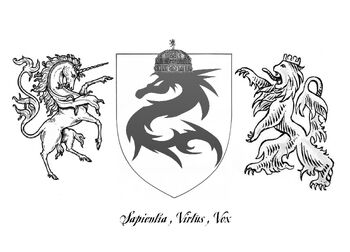
Crest of the Ossetian Royal Family.
The monarchy also have a title developed for formal use. The style of the current monarch is His Grace the Prince Revia Ambrai XIII of Ossetia. The style of the princess is Her Grace the Princess Helene of Ossetia. The style of the crown princess is Her Highness the Crown Princess Kateryn-Elise Ambrai of Ossetia. Only the reigning monarchs on the throne are granted the title of Grace - all other members of the royal family, such as the Princesses Liana and Elia (who, after marrying Prince Hasoun of Emiri, also has the Emirian title of Her Royal Highness the Duchess of Azouzopolis), are granted the title of Highness. The official cost of the royal family to the state is R£16,000,000, though rumours put it closer to R£22,000,000. Revia's full name, typically only referenced during formal occasions of state (usually twice a year), is Revia Amir Nohansen Lonarai Ambrai XIII. In Ossetia, the Crown Prince's second name is always his father's first name, thus Amir's name was Amir Riyan Nohansen Lonarai Ambrai XII, and so on. The name Nohansen is related to the last of the original Hylian royal line, the last "true" king before the tyrant Dragmire took the throne by force. It was added to the family name when Rohan Ambrai II married Princess Zelda Nohansen. Lonarai is the family name of Princess Aladra, wife of Link Ambrai I. Lonarai is an ancient noble Hylian name, it was added to Ambrai not just because it was the custom at the time to add the new wife's family name to her husband, but as a means of strengthening the Ambrai name as a noble one (previous to Link's marriage to Aladra, it was not). Ossetia is the only country in the world where the monarch's offical regnant name uses the surname rather than the personal - there are two reasons for this. The first is that Rohan Ambrai II was born before Link became prince of Ossetia, therefore he could not be called Link II. The second is that because the Hylian monarchy had been in place for so long, that when Ossetia was being established, there was a conscious effort to differentiate the new Ossetian rulers. The only exception was Link II, but the surname rule was maintained, and so he was called Link II Ambrai V. This odd manner of naming the prince has not been used since and is not a tradition that is likely to be revived.
Residences belonging or affiliated to the family include Athlante Castle, Reiza Palace, Wentyn Castle, Kiriko Manor and Athmyr House. Athlante Castle is the winter residence of the royal family, and the first royal residence. Reiza Palace, built in the reign of Ambrai III, is the royal family's summer residence, while Wentyn Castle is the residence of the Crown Prince.

Wentyn Castle.
Kiriko Manor is a large manor building on the very opposite end of Ossetia, built for the family of Lord Tilal just over a hundred years ago. It was given to the royal family by the state when the last of Tilal's family died sixty-seven years ago, and was recently the home of Princess Liana - after Liana's death, seeing as her children were all above the age of eighteen, ownership reverted to the crown. Ambrai XIII gave it to Prince Geir days after his coronation. Athmyr House was a private hunting lodge of Prince Rillon Ambrai IV. Upon his death it was converted into a proper home and became the retirement home of Princesses of the line if their husband died before them. It was last occupied by Princess Ianthe, wife of Prince Deniv Ambrai X. It is currently not occupied. Radzyn Palace, which began building under Ambrai IX, was to become the new residence of the royal family in Feruche, replacing Athlante. However, building was not completed for decades after Ambrai IX's death, and when it was finally finished, Ambrai XI handed it over to the state to be the central administration of the government, specifically the re-founded Magisterial Council.
Currently, the royal family continues to fulfil their traditional roles. Prince Revia is a former officer of the Royal Air Corps. and Geir was a corporal in the Ossetian Army until his death. Helene takes over from her husband in greeting foreign dignitaries to the country in place of the Crown Princess until she comes of age. The family insist on wearing more casual clothes than would normally be expected of a royal family, changing centuries of tradition. Until recently the family was very private and forbade pictures in the media of the children, but in recent years they have been taking on more roles and appear often at public functions.
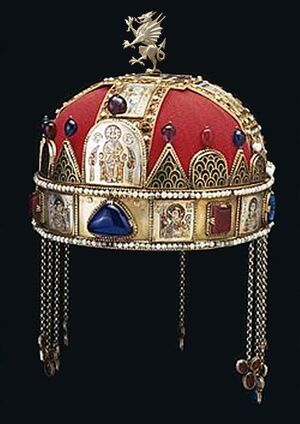
Crown of the Ossetian State, part of the Ossetian Crown Jewels
Like his father, Revia's salary is used up by the running and upkeep of Reiza Palace, the two private jets and the small cruise liner PV Goddess owned by the royal family, as well as some private charities.
One of the biggest events in the family in recent years was the marriage of HRH Prince Hasoun Adesocius, Duke of Azouzopolis of Emiri to HH the Princess Elia. The two royal families expressed happiness at the announcement of the engagement, and worked together to decide on the manner of the wedding, bearing in mind the difficult situation of the wedding itself with the required traditions of both countries. In the end, two ceremonies were performed, one in each country, and all traditions of royal weddings were reserved. It was one of the largest weddings in history and the union of the two great families has brought the two countries even closer. Elia, while retaining her Ossetian title of HH the Princess, has now adopted her husband's title as HRH the Duchess of Azouzopolis.
Because of the Karma War, the royal family relocated from Reiza Palace to Athlante Castle for security reasons. The armed forces deployed to the major cities and borders of the country as they defended Ossetia from the enemy. Soon after the royal family had moved, one of the opposing countries (Garageland of FEAR) launched a nuclear missile on the capital city, Feruche. The devastation was immediate, with the cities entire contingent of infantry wiped out in seconds, including a member of the family, Prince Geir. The royal family again moved, to Wentyn Castle. Since the nuclear attack on Feruche, a further four missiles were launched at the other major cities in the country, including Alvassy and Velenne. When the war ended, during the rebuilding, Prince Ambrai XIII announced that much of the country's severely limited resources would go to the development of a new military strategy, called the Strategic Defense Initiative. Ossetia would
launch a series of satellites capable of firing a laser at any oncoming nuclear missile, to reduce the massive damage dealt by these frightening weapons. This program has only just been completed.